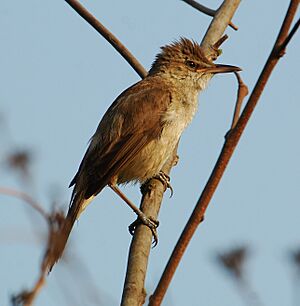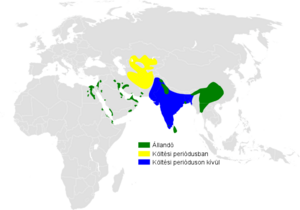Clamorous reed warbler facts for kids
Quick facts for kids Clamorous reed warbler |
|
|---|---|
 |
|
| Conservation status | |
| Scientific classification | |
| Genus: |
Acrocephalus (bird)
|
| Species: |
stentoreus
|
 |
|
| Distribution of Clamorous Reed Warbler Resident Breeding Non-breeding | |
The clamorous reed warbler (Acrocephalus stentoreus) is a type of Old World warbler. These are small songbirds. This bird lives in many places, from Egypt in the west all the way to south China and southeast Asia. You can also find it in countries like Pakistan, Afghanistan, and northern India. A special kind of clamorous reed warbler, called A. s. meridionalis, lives only in Sri Lanka.
Contents
What Does It Look Like?
The clamorous reed warbler is a fairly large warbler. It is about 18 to 20 centimeters long. That's about the size of a song thrush.
This bird has a plain brown back. Its belly and chest are whitish. It has a flat forehead and a strong, pointed beak. Both male and female clamorous reed warblers look the same. This is common for many warbler species.
It looks a lot like the great reed warbler. However, the great reed warbler has slightly richer colors on its belly. There are also different types of clamorous reed warblers. These types have slightly different feather colors. For example, the birds that migrate from the north have the richest brown feathers. The type found in Sri Lanka is the darkest.
What Does It Eat?
Like most warblers, the clamorous reed warbler mainly eats insects. But it will also eat other small creatures it can catch.
What Does Its Song Sound Like?
The clamorous reed warbler has a loud song. You can hear it from far away. It's not as rough-sounding as the great reed warbler's song. Its song is a slow, chattering sound. It often sounds like "kereet-kereet-kereet." It also includes whistles and can copy sounds from other birds.
Where Does It Live?
Most clamorous reed warblers stay in one place all year. They do not move around much. However, some birds that breed in Pakistan, Afghanistan, and northern India are migratory. This means they travel for the winter. They spend their winters in southern India and Sri Lanka.
This passerine bird likes to live in large areas of reeds. It often chooses places that also have some bushes. The female bird lays 3 to 6 eggs. She builds a basket-shaped nest right in the reeds.
Different Types of Clamorous Reed Warblers
Scientists have found nine different types, or subspecies, of the clamorous reed warbler. These different types live in various parts of the world. For example, one type lives in Egypt. Another type lives in Israel, Jordan, and Syria. There are also types found in places like Kazakhstan, India, China, the Philippines, and different islands in Indonesia. Each type has adapted to its specific home.


